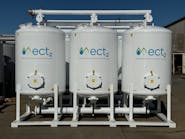Global Omnium is Valencia, Spain’s Water and Wastewater Utility, serving approximately 1.7 million people in the country’s third largest city. As a result of a 15-year journey, they completed a very successful digital transformation led by their technology spin-off, GoAigua. They were able to build a data-centric platform that today allows them to collect more than 6 billion data points per year from the entire utility and translate that data into incredibly valuable insights for the operation. This, together with the digitization of core processes, technological and cultural modernization, helped them become one of Europe’s most innovative utilities.
This transformation took place gradually. First, Global Omnium made a bold investment in equipping the entire network with sensors — with almost 1 million smart meters, today 100 percent of the city has AMI — and digitizing most maintenance and customer facing processes. This technological transformation allowed the utility to obtain a great amount of information and key data, represented in real-time environments. These early changes saved the company €7 million annually, which was then reinvested back into technology and integration.
Because of all the information and data being delivered by the sensors and Internet of Things (IoT) devices, the decision was made in 2010 to develop an IT platform, along with a scientific data unit, incorporating disruptive technologies such as machine learning and artificial intelligence. This experience allowed Global Omnium to develop ad hoc solutions that stitch together the separate systems and adapt to the different stages of the integral water cycle. An example of this includes their Digital Twin, one of the only “at-scale” digital twins worldwide today.
A digital twin consists of a virtual representation (usually of the form of a model such as hydraulic model, chemical-based models, or numerical models, etc.) of both the physical assets of a system as well as the behavior of the system. The model, if used for operations, leverages near real-time data from the physical “twin” (SCADA, IoT sensors, meter data, etc.) as input parameters for running the simulations.
As a result of their digital transformation, Global Omnium was able to build its digital twin in 2014, which allowed them to apply hydraulic modeling almost in real time (every 30 to 60 seconds), after performing a set of very advanced AI algorithms to automatically filter and clean the millions of data points retrieved every day from the entire utility. Along with GoAigua’s help, the main objectives of the Digital Twin were defined early on. They included long term planning as well as real-life operating support.
What do they use this for? Most value comes from improved operations and maintenance of the network. For example, thanks to the digital twin, the City of Valencia has a nearly perfect view of pressure and flow in all 15,000 nodes of the network. This ultimately helps them control pressure in an automatic way, minimize leaks, as well as improve customer experience in real time. In certain areas of the city, operators are even capable of locating leaks on the ground by leveraging the algorithms developed in the digital twin.
They also use this technology to perform what-if scenarios in real time and decide best time and day to perform network operations. And since AMI data is also leveraged to calibrate the model, they have a very accurate view of what is going to happen in the system during the next 24 hours, receiving early alarms if certain levels will likely be out of control such as water tank levels, or pressure. But this is just the beginning. They are also developing emergency response plans for extreme events with their Digital Twin and deciding on long term investments that optimize capex and risk level for the utility.
In just a few years, they reduced NRW and leaks gaining a 35–40 percent improvement in network efficiency, 1 billion gallons of unbilled water saved in the system annually and 2,500 leaks are reported every month. The customer experience was improved by nearly 60 percent, a 3–5 percent increase in revenue was achieved, and a 10-time client adoption of the digital platform. When it comes to operational efficiency, they experienced a 15 percent savings in energy costs, a maintenance opex savings of 20 percent and 2,000 TN reduction in CO2 emissions.
It is highly unlikely to achieve savings and efficiencies, as observed in Global Omnium, without having a digital twin. It was not easy to deploy and required a holistic and constant evolution of breaking down silos, application integrations, and change management. Global Omnium leveraged the 10 years of effort in building digital twin software into a set of modular applications as part of a spin-off company called GoAigua.
Today, the GoAigua platform integrates information coming from different vendors and equipment including on-field components, IoT devices, proprietary and third-party data. As an example, the digital twin of Valencia and its metropolitan area is very accurately calibrated, with an error rate of less than 2 percent in pressures and 4 percent in flows, which also precisely reproduces all the tank levels. The success of the digital twin is only possible because of the data-centric platform, that is supported by a service layer with big data capabilities. The data centric strategy and model links the necessary attributes to all utility elements in a standard way. It is independent and capable of processing any information from any vendor and data protocol. It is smart, as it supports big data and machine learning algorithms and modular because it is easy to integrate with third party solutions.
The organization and utility culture were key in delivering results quickly. Global Omnium began to see constant collaboration between areas at every level in the organization. The organization became agile and this shortened development cycles and inter-departmental silos. A culture of innovation was created, integrating third party solutions when necessary. WW




